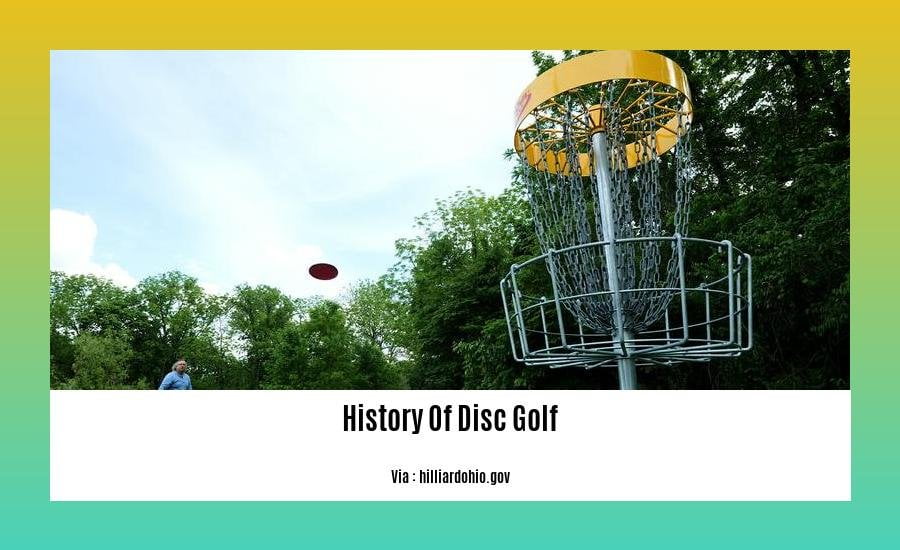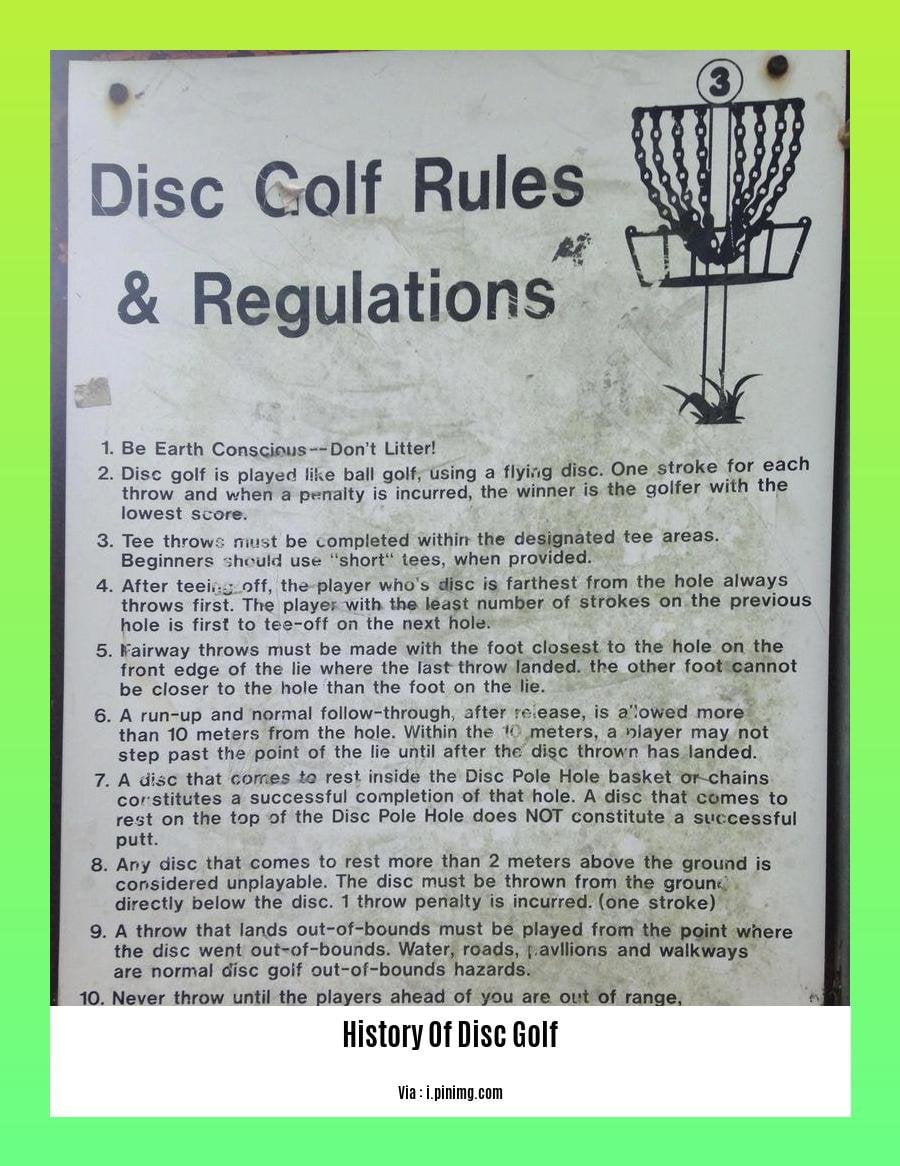Unveiling the fascinating journey of disc golf, [Tracing the Trajectory: A Comprehensive History of Disc Golf’s Evolution and Triumphs] delves into the captivating narrative of this exhilarating sport. From its humble beginnings to its current global recognition, we embark on an exploration of the key milestones, influential figures, and captivating stories that have shaped disc golf’s rise to prominence.
Key Takeaways:
Disc golf emerged in the early 1960s and was officially introduced in 1968 through the “Frisbee Golf” tournament in Pasadena, California.
Steady Ed Headrick, known as the “father of disc golf,” revolutionized the sport by inventing the modern disc golf target, the Disc Pole Hole, in 1977.
The Professional Disc Golf Association (PDGA), founded in 1976, has played a crucial role in governing and promoting the sport.
The inaugural World Disc Golf Championships were organized by the PDGA in 1982 and have been held annually ever since.
Disc golf courses offer diverse terrain, from parks to forests to mountains, with varying distances and challenges.
Players use a variety of discs specifically designed for different throws and distances.
Scoring follows a similar principle to traditional golf, with the objective of completing the course in the fewest strokes.
In 1988, the PDGA recognized disc golf as a professional sport, establishing rules and regulations and sanctioning tournaments.
The sport has grown tremendously, now played in over 40 countries with over 2 million active players.
Disc golf has gained international recognition and is currently pursuing inclusion in the Olympic Games, supported by the International Olympic Committee.
History of Disc Golf: Unveiling the Legacy of a Thriving Sport

From Humble Origins to Soaring Triumphs
Disc golf, a sport that captivates enthusiasts worldwide, traces its roots back to the early 1960s, when scattered groups engaged in informal play using rudimentary rules and equipment. The sport’s official inception, however, can be traced to 1968, with the inaugural “Frisbee Golf” tournament held in Pasadena, California, marking a pivotal moment in its evolution.
Shaping the Course: Influential Figures and Milestones
In 1977, Steady Ed Headrick, a visionary in the disc golf realm, revolutionized the sport by introducing the Disc Pole Hole, the forerunner of the modern disc golf target. Headrick’s invention propelled the sport’s trajectory, earning him the title of “father of disc golf.”
To foster the growth and standardization of the sport, the Professional Disc Golf Association (PDGA) emerged in 1976. This governing body played a crucial role in establishing rules, regulations, and tournaments, propelling disc golf toward organized competition.
In 1982, the PDGA organized the first World Disc Golf Championships, an annual event that showcases the prowess of the sport’s elite players. This prestigious tournament has played a pivotal role in elevating disc golf’s status and attracting worldwide recognition.
Embracing Diversity: Terrain, Equipment, and Gameplay
Disc golf courses, often nestled in scenic parks, forests, or mountainous landscapes, offer a diverse range of challenges and terrains. These courses comprise a variety of hole lengths and difficulties, catering to players of all skill levels.
The sport’s arsenal of discs, each uniquely designed, caters to various throws and distances. Players strategize their shots, selecting the most suitable disc for each situation, akin to the club selection in traditional golf.
Similar to traditional golf, disc golf players tee off from designated areas, aiming to land their discs in designated targets. The total number of strokes taken to complete the course determines the player’s score, with the lowest score emerging victorious.
Ascending to Professionalism and Global Recognition
In 1988, the PDGA bestowed professional status upon disc golf, solidifying its position as a legitimate competitive sport. The organization’s ongoing efforts in sanctioning tournaments and establishing regulations have played an instrumental role in shaping the sport’s professional landscape.
From a humble pastime to a globally recognized sport, disc golf has garnered a loyal following, with over 2 million active players representing more than 40 countries. Its popularity continues to soar, attracting enthusiasts of all ages and backgrounds.
The Future Unfolds: Olympic Aspirations and Beyond
Disc golf’s rise has not gone unnoticed by the International Olympic Committee (IOC). The sport’s inclusion in the Olympic Games is a testament to its growing prominence and recognition as a legitimate competitive discipline.
As disc golf continues to expand its global footprint, the future holds endless possibilities for the sport’s growth and evolution. With its unique blend of athleticism, strategy, and accessibility, disc golf is poised to captivate even more hearts and minds, leaving an indelible mark on the world of sports.
Get amazed by the fascinating journey of digital printing by exploring the depths of its history and how it revolutionized the printing industry. history of digital printing
Discover the captivating tale of dressmaking through the ages, from its humble beginnings to its current status as a globally renowned art form. history of dressmaking
Delve into the depths of the EMS timeline and trace the evolution of this vital service, from its early roots to its current status as an indispensable part of our healthcare system. history of ems timeline
Unravel the rich tapestry of English drama in the 11th grade, exploring its origins, key players, and lasting impact on literature and society. history of english drama 11th class
The Rise of Professional Disc Golf and the Impact of Key Tournaments

In the realm of outdoor sports, disc golf has soared from humble beginnings to become a captivating phenomenon that continues to attract enthusiasts worldwide. Its evolution into a professional sport, marked by the emergence of key tournaments, has played a pivotal role in its rise to prominence.
The Pioneers: Paving the Path to Professionalism
In the early days, disc golf enthusiasts forged their own paths, competing in informal tournaments and establishing a sense of community. The Professional Disc Golf Association (PDGA), founded in 1976, became the driving force behind standardizing rules, regulations, and tournaments, providing a framework for the sport’s growth.
The Rise of Professional Disc Golf
The late 1980s witnessed a surge in the popularity of disc golf, fueled by the growing number of tournaments and the emergence of professional players. The PDGA bestowed professional status on disc golf in 1988, granting legitimacy to the sport and attracting a wider range of participants.
Key Tournaments: Shaping the Landscape
The emergence of key tournaments served as a catalyst for the rise of professional disc golf. Among these, the PDGA World Championships, inaugurated in 1982, stands as the most prestigious event in the sport’s calendar. Other notable tournaments, such as the United States Disc Golf Championship (USDGC) and the European Open, have also played a crucial role in shaping the competitive landscape. These tournaments not only showcased the skills of elite players but also provided a platform for up-and-coming talent to make their mark.
The Impact of Professional Disc Golf
The rise of professional disc golf has had a profound impact on the sport’s trajectory. It has elevated the level of competition, attracting top athletes from around the globe. The increased visibility and recognition have spurred the growth of disc golf courses, manufacturers, and related businesses, contributing to the sport’s economic impact.
Key Takeaways:
- The PDGA’s establishment in 1976 laid the foundation for the standardization and growth of disc golf.
- The granting of professional status in 1988 marked a significant milestone in the sport’s evolution.
- Key tournaments, such as the PDGA World Championships, have played a pivotal role in shaping the competitive landscape.
- The rise of professional disc golf has increased its popularity, attracting top athletes and boosting its economic impact.
References:
[1] PDGA: https://www.pdga.com/history
[2] Disc Golf Association:
The evolution of disc golf course design and equipment
From simple Frisbees to highly specialized discs, the equipment used in disc golf has undergone a remarkable transformation. In the early days, players relied on generic Frisbees, which were not designed for the accuracy and distance required for the sport. As the sport gained popularity, manufacturers began to produce discs specifically designed for disc golf, with various shapes, weights, and flight characteristics. These specialized discs allowed players to throw with greater accuracy and control, leading to improved scores and more exciting gameplay.
The evolution of disc golf course design has paralleled the development of equipment. Early courses were often makeshift, with players using whatever terrain was available, such as parks, fields, and wooded areas. As the sport grew in popularity, dedicated disc golf courses began to emerge. These courses were designed with the specific needs of the sport in mind, featuring a variety of hole lengths and difficulties, as well as obstacles such as trees, water hazards, and elevation changes.
Key Takeaways:
- The early days of disc golf were marked by the use of generic Frisbees and makeshift courses.
- The introduction of specialized discs and dedicated courses significantly improved the accuracy, distance, and overall gameplay of disc golf.
- Modern disc golf courses offer a diverse range of hole lengths, difficulties, and obstacles, providing a challenging and enjoyable experience for players of all skill levels.
References
- A Brief History of Disc Golf
- The Evolution of Disc Golf Course Design
The growing popularity of disc golf and its impact on the sports landscape
Disc golf, a sport that’s taken the world of outdoor pursuits by storm, has witnessed an astronomical rise in popularity over the years. If you’re wondering what the fuss is all about, let’s take a closer look at this captivating sport and its significant impact on the world of sports.
Understanding Disc Golf: A Thrilling Journey into Nature’s Fairways
Picture this: an idyllic course set amidst towering trees, lush meadows, and sparkling streams. Players, fueled by a mix of skill and strategy, launch colorful discs toward suspended baskets, aiming for accuracy and finesse. That’s the essence of disc golf, a mesmerizing sport played on a par with traditional golf, but with one crucial difference – instead of hitting balls, players hurl aerodynamic discs towards their targets.
The Allure of Disc Golf: Why It’s Capturing Hearts and Minds
So, what’s the secret behind disc golf’s meteoric rise? Buckle up for a whirlwind tour of its captivating features:
Unparalleled Accessibility: Disc golf welcomes players of all ages, abilities, and fitness levels. Whether you’re a seasoned athlete or a novice seeking an enjoyable outdoor activity, this sport welcomes you with open arms.
Low-Cost Entry: Unlike traditional golf, disc golf doesn’t demand a hefty investment in expensive equipment. With just a few discs in your bag, you’re ready to hit the course.
A Sport for All Seasons: With courses designed to withstand varying weather conditions, disc golf can be enjoyed year-round. Rain or shine, players can indulge in this thrilling pursuit.
Social Butterfly’s Delight: At its core, disc golf is a communal experience, fostering camaraderie and friendships among players. You’ll find yourself immersed in a welcoming community that shares your passion for the game.
The Impact of Disc Golf: A Force Shaping the Sports Landscape
Disc golf’s popularity has sparked a ripple effect, sending waves of positive impact throughout the sporting world:
Economic Boost: With its growing number of participants, disc golf has emerged as a catalyst for economic growth, creating job opportunities and injecting revenue into local economies.
Green Revolution: As a sport played amidst nature’s beauty, disc golf promotes environmental stewardship and sustainability, encouraging players to cherish and protect their surroundings.
Accessibility Champion: By breaking down barriers to participation, disc golf embraces inclusivity, providing opportunities for individuals of all abilities to engage in an active and fulfilling sport.
A Gateway to Wellness: Beyond the physical benefits of an active lifestyle, disc golf offers a mental and emotional sanctuary, promoting stress relief and enhancing overall well-being.
Key Takeaways:
Disc golf has experienced a meteoric rise in popularity due to its accessibility for players of all ages and abilities, low-cost entry, all-season playability, and social camaraderie.
The impact of disc golf extends beyond the course, generating economic growth, promoting environmental stewardship, fostering inclusivity, and nurturing personal well-being.
References:
[1] Why Disc Golf Is So Popular – UDisc
[2] Disc Golf’s Growing Popularity and Impact on the Sports Landscape









